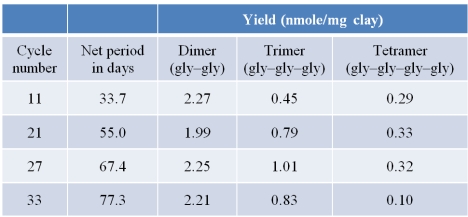Refer to the table below showing data obtained from laboratory experiments that used the amino acid glycine in combination with a clay mineral kaolinite.The combination was subjected to repeated cycles of wetting and drying over many days.At various times during these cycles, samples were analyzed for changes, specifically the yield of glycine dimers, etc.Control samples without kaolinite produced no change in glycine.  Which hypothesis about the origin of life on Earth do these data support?
Which hypothesis about the origin of life on Earth do these data support?
Definitions:
Expansion
The process of becoming larger in size, volume, quantity, or scope.
New Procedures
Innovations or changes introduced to existing methods or processes in any field or industry.
HCPCS Level II
A standardized coding system used to identify products, supplies, and services not included in the American Medical Association's CPT codes, primarily for Medicare patients.
IV Pole
A medical apparatus designed to hang bags of fluid or medication that are administered intravenously through a drip.
Q7: Which statement about chemical reactions is false?<br>A)
Q26: Homogenization of rat liver cells results in
Q52: Some RNA molecules can act as catalysts.Catalytic
Q84: You discover what looks to be a
Q128: Refer to the table below. <img src="https://d2lvgg3v3hfg70.cloudfront.net/TB5650/.jpg"
Q148: The reaction H-A-OH + H-B-OH <font face="symbol"></font>
Q174: Refer to the figure below showing the
Q176: Refer to the diagram of a polysaccharide
Q208: Refer to the figure showing the tertiary
Q237: A laboratory model of a prebiotic structure